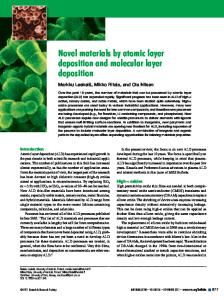Oxide ion conduction of yttria-stabilized zirconia films deposited by atomic layer deposition
- PDF / 1,099,394 Bytes
- 4 Pages / 612 x 792 pts (letter) Page_size
- 86 Downloads / 415 Views
1098-HH03-18
Oxide ion conduction of yttria-stabilized zirconia films deposited by atomic layer deposition Cheng-Chieh Chao1, Hong Huang2, Joon Seok Park3, and Fritz B. Prinz1 1
Mechanical Engineering, Stanford University, Stanford, CA, 94305
2
Mechanical and Materials Engineering, Wright State University, Dayton, OH, 45435
3
Materials Science and Engineering, Stanford University, Stanford, CA, 94305
ABSTRACT Yttria-stabilized zirconia (YSZ) is one of the most common electrolytes in high temperature solid oxide fuel cell (SOFCs). We developed methods to fabricate the electrolyte of SOFC with the help of atomic layer deposition (ALD). Our group demonstrated that ultra-thin ALD YSZ SOFSs deliver high power densities at low temperatures [1]. These SOFCs demonstrated not only reduction of Ohmic loss, but also enhancement of surface kinetics. The focus of this work is to investigate surface and bulk conduction characteristics of YSZ films produced by ALD. In plane conductivity was measured as a function of film thickness and temperature. YSZ thin films were deposited on standard 4” quartz substrates with thicknesses ranging from 8 nanometers to 55 nanometers. Micro-electrodes were patterned on top of the ALD YSZ layer by standard photolithography process. The impedance of the YSZ thin films with different thickness was measured. We have observed higher conductivities for thinner films that we attributed to higher oxide ion conductivity in the vicinity of the surface. Similar observations were made in YSZ films produced by electron beam evaporation [2]. INTRODUCTION Recent successes in fabricating YSZ membrane by ALD enabled us to produce ultra-thin electrolyte membranes for SOFC. We have already observed that by reducing the thickness of the electrolyte to nanometer scale, the Ohmic loss for SOFC may be greatly reduced, which enabled SOFC operation at comparatively low temperatures [3]. However, the surface kinetics of ALD YSZ appears enhanced relative to YSZ membranes produced by other methods, which may be related to higher ionic conductivity along the surface. The surface and bulk conductivities of the ALD YSZ are characterized by measuring the in plane impedance of YSZ membranes with different thicknesses. In thin membranes, conduction in the surface region is comparatively more important.
EXPERIMENTAL DETAILS The ALD YSZ is produced with sequential deposition of zirconia and yttria [4]. The precursors for zirconia and yttria are tetrakis(dimethylamino)zirconium (Sigma Aldrich) and Tris(methylcyclopentadienyl)yttrium (Strem Chemicals). Oxidant for both oxides is distilled water. We measured the conductivity parallel to the ALD YSZ film as a function of the thickness ranging from 8nm to 55nm (figure 1). All measurements were performed in air.
Pt
Pt ALD YSZ
Quartz Substrate
Figure 1. Illustration of ALD YSZ impedance measurement setup. Standard 4” quartz wafers provide an insulating substrate for YSZ deposition. The wafers were coated with ALD YSZ by layering zirconia and yttria depositions with a ratio of
Data Loading...










